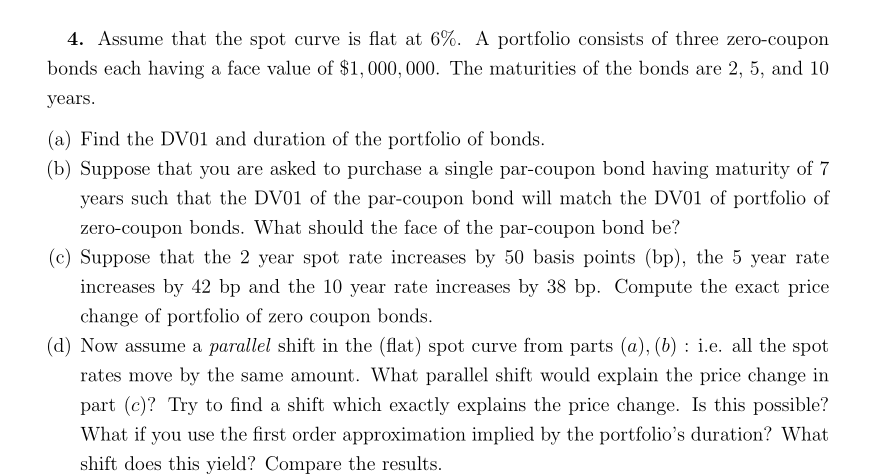
4. Assume that the spot curve is flat at 6%. A portfolio consists of three zero-coupon bonds each having a face value of $1,000,000. The maturities of the bonds are 2, 5, and 10 years. (a) Find the DV01 and duration of the portfolio of bonds. (b) Suppose that you are asked to purchase a single par-coupon bond having maturity of 7 years such that the DV01 of the par-coupon bond will match the DV01 of portfolio of zero-coupon bonds. What should the face of the par-coupon bond be? (c) Suppose that the 2 year spot rate increases by 50 basis points (bp), the 5 year rate increases by 42 bp and the 10 year rate increases by 38 bp. Compute the exact price change of portfolio of zero coupon bonds. (d) Now assume a parallel shift in the (flat) spot curve from parts (a), (b): i.e. all the spot rates move by the same amount. What parallel shift would explain the price change in part (c)? Try to find a shift which exactly explains the price change. Is this possible? What if you use the first order approximation implied by the portfolio's duration? What shift does this yield? Compare the results. 4. Assume that the spot curve is flat at 6%. A portfolio consists of three zero-coupon bonds each having a face value of $1,000,000. The maturities of the bonds are 2, 5, and 10 years. (a) Find the DV01 and duration of the portfolio of bonds. (b) Suppose that you are asked to purchase a single par-coupon bond having maturity of 7 years such that the DV01 of the par-coupon bond will match the DV01 of portfolio of zero-coupon bonds. What should the face of the par-coupon bond be? (c) Suppose that the 2 year spot rate increases by 50 basis points (bp), the 5 year rate increases by 42 bp and the 10 year rate increases by 38 bp. Compute the exact price change of portfolio of zero coupon bonds. (d) Now assume a parallel shift in the (flat) spot curve from parts (a), (b): i.e. all the spot rates move by the same amount. What parallel shift would explain the price change in part (c)? Try to find a shift which exactly explains the price change. Is this possible? What if you use the first order approximation implied by the portfolio's duration? What shift does this yield? Compare the results







